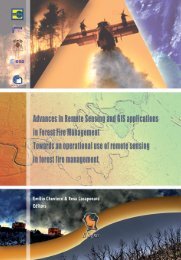EARSeL Newsletter - EARSeL, European Association of Remote ...
EARSeL Newsletter - EARSeL, European Association of Remote ...
EARSeL Newsletter - EARSeL, European Association of Remote ...
Create successful ePaper yourself
Turn your PDF publications into a flip-book with our unique Google optimized e-Paper software.
<strong>EARSeL</strong> <strong>Newsletter</strong> September 2002 - Number 51<br />
26<br />
tion by a passing storm-front. The results<br />
so far are "very encouraging," says Miller,<br />
but there is more to do. For example, each<br />
pixel in the images from these satellites<br />
represents one square kilometer on the<br />
ground, so the application <strong>of</strong> this remote<br />
sensing technology is currently limited to<br />
large bodies <strong>of</strong> water.<br />
The research team is now starting a new<br />
phase <strong>of</strong> field trials incorporating data<br />
from the MODIS (Moderate Resolution<br />
Imaging Spectro-Radiometer) satellite sensor,<br />
which has a better ground resolution<br />
(one sixteenth <strong>of</strong> a square kilometre).<br />
MODIS is on two NASA satellites – Terra<br />
and the recently launched Aqua – which together<br />
will provide two snap-shots per day,<br />
one in the morning and one in the afternoon.<br />
The field trials have also expanded to<br />
a new site at Pamlico Sound in North Carolina.<br />
In collaboration with Reide Corbett<br />
<strong>of</strong> East Carolina University, this phase <strong>of</strong><br />
the trials will focus on the effects <strong>of</strong> fishing<br />
trawls or bottom nets. Ultimately, the researchers<br />
want to construct a system for<br />
delivering an executive-summary version<br />
<strong>of</strong> the satellites' observations to the regulators<br />
and decision-makers who need it.<br />
Miller says that his team's goal is to collaborate<br />
with decision makers in the region to<br />
design a system to suit their needs. He expects<br />
that the project could be producing<br />
these executive reports within six months.<br />
This article is based on a report at science.nasa.gov/headlines/y2002/05sept_es<br />
tuaries.htm?list158594.<br />
4.12 EADS FLEXIMAGE’s IMINT -<br />
Online s<strong>of</strong>tware<br />
The past two years have seen a booming<br />
supply <strong>of</strong> commercially available new<br />
high-resolution imagery, which has drawn<br />
a lot <strong>of</strong> interest within the military intelligence<br />
community worldwide, as well as<br />
users who process images for a wide range<br />
<strong>of</strong> civilian applications. However, the consequences<br />
<strong>of</strong> this new high-resolution imagery,<br />
too <strong>of</strong>ten ignored, are a growing<br />
complexity <strong>of</strong> image interpretation due to<br />
the high density <strong>of</strong> features now visible on<br />
the images, and subsequently, the increased<br />
importance <strong>of</strong> experts involved in<br />
their analysis. Today, the key to perfor-<br />
mance and optimum use <strong>of</strong> the available<br />
information entirely depends on the experience<br />
and efficiency <strong>of</strong> the image analysts<br />
themselves. The efficiency is more than<br />
ever dependent on intellectual capital: the<br />
knowledge and experience <strong>of</strong> the experts.<br />
Several major governmental organisations<br />
already use EADS FLEXIMAGE solutions<br />
for the capture <strong>of</strong> experience and management<br />
<strong>of</strong> information in the field <strong>of</strong> image<br />
analysis. This is done using the revolutionary<br />
IMINT-Online services: Knowledge<br />
Database Management, Consulting and<br />
Training. IMINT-Online gives access to a<br />
database designed for use by image analysts.<br />
Based on a multi-media concept, and<br />
structured by themes, it describes environmental<br />
features, typical infrastructures or<br />
facilities, which can be observed by the<br />
image analyst.<br />
The analyst may also enrich the database<br />
by creating and storing specific data structures<br />
related to his application. By using<br />
IMINT-Online, the image analyst faced<br />
with an interpretation problem may consult<br />
the database in order to identify the<br />
feature with certainty, and obtain multimedia<br />
information about it. If the feature<br />
represents a specific interest, the analyst<br />
can capture it from the image and insert it<br />
into the database, with associated comments<br />
and multi-media representation<br />
such as animated drawings, voice-over, etc.<br />
In this way IMINT-Online answers various<br />
needs. For example, an image analysis centre<br />
specialised in crop monitoring can<br />
archive all relevant spectral signatures on<br />
wheat fields, whose properties may vary<br />
according to many factors such as the sensor,<br />
number <strong>of</strong> spectral bands or conditions<br />
<strong>of</strong> acquisition. Other analysts specialised<br />
in, say, radar images can consult the database<br />
to determine step-by-step, with<br />
greater confidence, the nature <strong>of</strong> the object<br />
they want to identify. They may also save<br />
this experience by filing all significant signatures<br />
corresponding to a specific facility<br />
or infrastructure, such as an industrial<br />
plant.<br />
Another asset <strong>of</strong> FLEXIMAGE’s solutions<br />
is the ability to share experience among the<br />
team, and to give the necessary specific<br />
background to newcomers. The growing
















